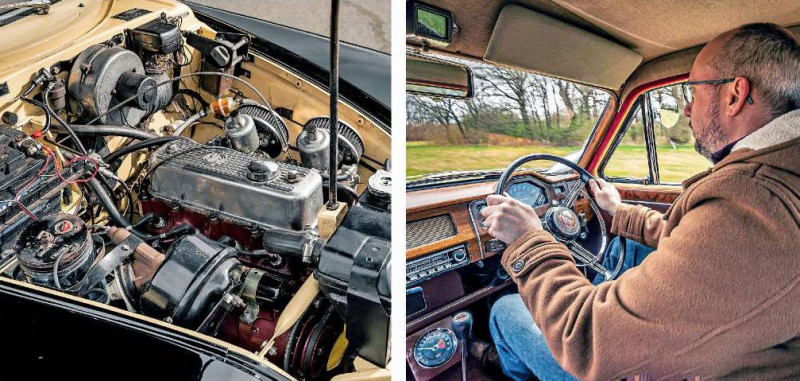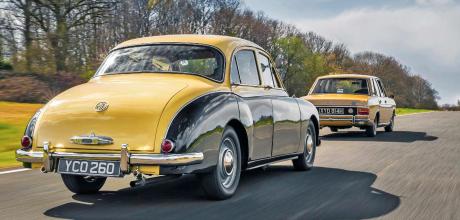1958 MG Magnette ZB Varitone
Ask most traditionalists what constitutes a great driving machine and they’ll tell you it has two doors, no roof and a big engine. That’s been the standardised formula for driving nirvana for nearly as long as the car itself. As owner’s priorities change, fun behind the wheel can often evaporate – but it doesn’t have to. A sports saloon not only keeps your pulse racing, but negates the need for a beady eye on the weather forecast or to leave family or friends behind.
These perpetually undervalued performance machines broaden our ability to make great driving memories. They might have extra seats and a roof, but the best remain sports cars at heart. Which of our classic saloon selection disguises this true identity, and which wears it on its sleeve? That’s what we’re here to find out...

Who says driving enjoyment has to stop when you have a family? From post-war to (nearly) present, here are five fine driver’s cars that also have ample room to share the experience
To kick off, we’ll slide into the big, comfy armchair seating of the MG Magnette ZB Varitone, and before dealing with its driving qualities, let’s explore why it’s here. There had been sporty saloons before the October 1953 London Motor Show debut of the Magnette, yet few nailed the formula as effectively. In much the same way as Volkswagen’s original Golf GTI would come to define the hot hatch, the Magnette took all the established sports saloon elements and fused them into something new.
Period Magnette advertising heavily emphasised the machine’s sporting nature. It was even pictured alongside the 300bhp land-speed record MG EX181. The Magnette was also comfortably more advanced than either of the ‘proper’ sports cars it was sold alongside – the T-type Midget and MGA. It wasn’t just its unitary construction, shared with the Wolseley 4/44, which was a first for Abingdon, but also its new 1489cc B-series engine. Unlike much advertising hyperbole before and since, the Magnette had the goods to back it up, which helped MG to sell a total of 36,601 by the end of ZB production in 1958.
What matters today is whether this saloon that’s approaching its 70th birthday can still convey the qualities that made it a driver’s favourite. Well, for starters the mid-range torque from the B-series immediately makes strides in that direction. NVH wasn’t really a consideration in the Fifties – you seem to sense every rotation of its three-bearing crankshaft through your teeth, yet a lovely burble begins in the middle of its rev range. Just as intake and exhaust notes seem to harmonise, the engine finds a sweet spot. Performance below this threshold is best described as unhurried; afterwards, it’s very nearly sufficient.
Matters improve considerably when we take this MG through some bends. Its relatively complicated double-wishbone and lower-locating-arm front suspension is twinned with fairly lazy but accurate rack and pinion steering. Despite the steering wheel connected to the latter being roughly the size of the helm fitted to a yacht, it answers well. The whole chassis follows suit, feeling eminently secure and encouraging you to press on.
Doing so starts to unravel the fantasy a little, with anti-roll bars being missing in action. It’s also best not to ask too much of the centre pedal – this particular example has been gifted a brake servo, but it’s still only magnifying pressure to four ten-inch drums. The best sports saloons have to excel on both the spirited drive and the commute. While it’s safe to say there are probably better rugby-club pool vehicles, for most owners wishing to fill all its seats the dimensions on offer in this MG will prove adequate, if intimate. There are some enchanting touches to the interior that offer a treat for the observant. The half octagon of the dash top and the rope door pulls are just two of these – the ever-evocative mix of tweed and wood providing a further feast for the senses.
In common with nearly all early monocoque designs, Magnettes attract rust like a lump of iron in a rock pool. It’s far easier to point out areas where the Magnette doesn’t rot, but nevertheless it’s worth keeping an eye on the trailing edges of the rear wings and boot floor, plus the rear spring hangers. Terminal rust in the bulkhead and pedal box has also been reported in severely neglected examples, as has a leaky windscreen. The latter is particularly troublesome, because replacement trim is scarce. This MG certainly offers great value – the entry-level cost for a running and useable Magnette is just £4000. A more cost-effective bet would be stretching to a £6000-£8000 cherished example, or even a £10,000 to £12,000 prize winner. The difference in value essentially comes down to the condition of trim and bodywork – mechanical parts are robust and easily replaced.
The Magnette remains very attainable, highly tuneable and mechanically fairly rugged. As our opening gambit into the world of the classic sports saloon, we could have done an awful lot worse.
‘The Magnette was more advanced than the ‘proper’ sports cars it was sold alongside’

Secure chassis responds well to steering inputs The B-series engine makes for everyday reliability
Owning an MG Magnette ZB
Australian David Halliday has had his MG since 2010. ‘I got into the Magnette because my wife Kerri liked them, I was more of a sports car fan,’ he explains. ‘We bought our first one back in 2002 when we were still in Melbourne; we still have it over there. While I was living here in the UK I thought that I’d better buy a Magnette. ‘It’s only come home on the back of a recovery truck three times. – the big end bearings went, leading to an engine rebuild. A chap called Peter Martin is effectively the global parts supplier – he’s great. I cover about 1000- 1500 miles a year, mainly to shows. Magnettes are pretty straightforward and I’m quite mechanically adept, so it’s mainly just keeping on top of servicing and grease points.’
TECHNICAL DATA 1958 MG Magnette ZB Varitone
- Engine 1489cc, inline four-cylinder, ohv, twin SU H4 1½-inch carburettors
- Power and torque 68bhp @ 5400rpm; 83lb ft @ 3000rpm
- Transmission Four-speed manual (synchromesh on second-fourth), rear-wheel drive
- Steering Unassisted rack and pinion
- Suspension Front: independent, coil sprung with double wishbones and locating arms, telescopic Girling hydraulic dampers (fitted within the coil springs). Rear: live axle with half-elliptic leaf springs, telescopic hydraulic dampers (angled)
- Brakes Drums all round
- Performance 0-60mph: 18.5sec.
- Top speed: 86mph
- Weight 1123kg (2476lb)
- Fuel consumption 31mpg
- Cost new £915
- Classic Cars Price Guide £6000-£15,000


